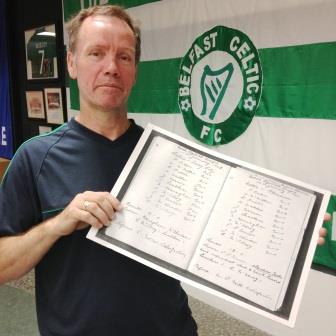|
| |
|
The Irish football referee who was history’s eyewitness |
| |
Dunville Park was once a jewel in the crown of west Belfast, with its ornate terracotta fountain entertaining patients and patrons at the Royal Victoria Hospital nearby.
Over many years, the park and its fountain fell into a state of serious disrepair and only recently, Belfast City Council has restored the park to something near its former glory.
Built by the Dunville family, linked inextricably to the whiskey distillery which lay on the edge of the City Centre, the Park was gifted to the corporation in 1891 and in 1892, the Marquis of Dufferin opened it to the citizens of Belfast. This wasn’t the only mark the Dunville’s left, as their Distillery football team remains a fixture on the local football scene.
At the Grosvenor Road end of Dunville Park, there once stood a majestic gate lodge, which housed shelters for children’s swings and was kept by a Park Superintendant, to keep a keen eye that the park was on good order.
For many years, William O’Neill was ensconced in the sandstone gate lodge, watching the children come and go from the mill streets surrounding the park, but his real passion wasn’t gardening – it was football – and he was also a top grade referee. |
|
|
His grandson, Brian Courtney, paid a recent visit to the Belfast Celtic Museum and rolled out the details of his grandad’s colourful past, which included a role in one of the most famous Belfast Celtic matches of all time.
Brian remembers his granda’s home in Dunville Park very well, remarking that it was stuffed with programmes and memorabilia of his granda’s storied career as a ref.
He recalls; “My grandfather was a park ranger for the Belfast Corporation and his house was a football treasure trove – he refereed some huge matches in his career and was always in demand - at one point he was approached to go and referee in Brazil – but he declined. He reffed at the top of the game and after a dispute with the Irish Football Association, he ended up down south refereeing in the League of Ireland. He was a Cliftonville man, but had many friends at Belfast Celtic, including Elisha Scott and Mickey Hamill – he knew them all."
“When I was a boy, we emigrated to America and when we returned a few years later, his house in the park had been demolished and he was living in the new estate at Turf Lodge. He had tried to buy the property but the Corporation refused and made him move out before they knocked the gate lodge down – all these gate lodges are now being refurbished, it was so short sighted. He then moved in with us in our home at Springfield Park but much of his belongings had been lost when he moved home. For many years I had his whistle, kept in a little box and the wee pea inside was all shriveled away.” |
 |
What William will be remembered most for though, is for officiating at the game where a famous sporting record was set – when Belfast Celtic beat Glenavon thirteen to zero and striker Peter O’Connor bagged eleven of the total goals.
Brian explained; “My granda was referee for the game when Belfast Celtic beat Glenavon thirteen to nil. Peter O’Connor scored eleven goals that day, an Irish record and my granda blew the whistle after each of the goals”
Played out in the Northern Regional League, during World War Two, January 25th 1941 is the day that has gone down in Belfast Celtic folklore.
With Celtic bristling with talent like Tommy Breen, Jimmy McAlinden and Norman Kernoghan, they simply swept poor Glenavon aside at Celtic Park, providing a thumping rarely seen in Irish football.
Celtic’s manager Elisha Scott kept a record of each of the games he managed and the entry for this game is available to view at the Belfast Celtic Museum. |
|
Each player received a rating, as did the referee for the day and despite scoring eleven of Celtic’s thirteen goals, Peter O’Connor is simply rated as ‘Good’, same as the other scorers, Hack Leathem and Charlie McIlroy!
What sort of performance would you have to have produced to receive a mark of “Brilliant’ or ‘Excellent’? William O’Neill’s rank is also marked at the foot of the page and Scott puts the whistler’s performance simply as ‘Satisfactory’.
Often, refs would be marked as ‘poor’, and sometimes, ‘good’.
Unfortunately, there are no rankings for the poor Glenavon side, but what is interesting to note is that the man in the goals that day – who watched thirteen goals whizz past him – was later signed by Elisha Scott to play for Belfast Celtic.
Madcap Hugh Kelly from Lurgan was one of the most popular Celts of the 1940’s and, according to Elisha Scott, if it hadn’t been for him in goals for Glenavon on that fateful day in 1941, Celtic’s goal tally would have been even higher! |
|
Brian Courtney is incredibly proud of his grandfather and believes he has also gone down in sporting legend, saying; “I remember getting a copy of the History of Glenavon FC and my granda was listed in the report on this famous game. “I showed my mother and read her out the details – we were all so proud he had been remembered in that way.”
In July 2013, O’Neill’s former home, Dunville Park, was re-opened after a multi-million pound makeover.
It gives cause to wonder what O’Neill would have thought of the fact that on the exact site of his former home, the old gate lodge, now sits a brand new football pitch.
We can only imagine he would heartily approve! |
|
|
|
|
|